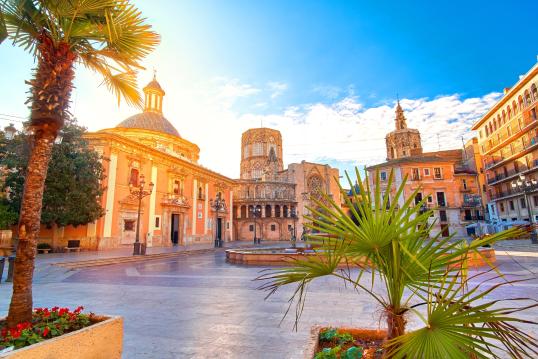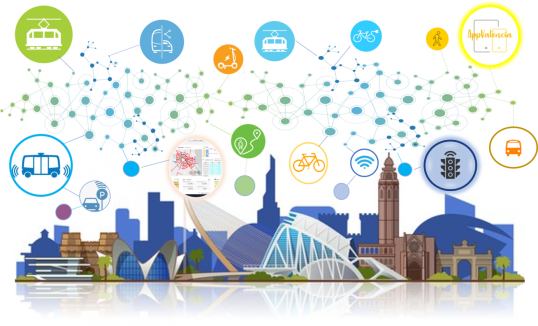- Topic
- Urban mobility planning
- Country
- Spain
- Resource type
- Case study
First published on 7 September 2021.
The city of Valencia is striving to become the first fully integrated smart city in Spain. It is certainly a ground-breaker, having consolidated all of its services on a cloud platform. The solutions developed as part of its smart city strategy provide powerful tools to develop, implement and monitor the implementation of its Sustainable Urban Mobility Plan (SUMP) and promote sustainable urban mobility throughout the city.
Context
Valencia is a municipality and a city in Spain, capital of the eponymous province and the Valencian Community. With a population of over 800,000, it is the centre of a metropolitan area of more than one and a half million people. The city contains 16% of the population of the Valencian Community and is, by population, the third largest city in Spain. The city is committed to innovation and sustainability as the basis for its development, respecting people and the environment.
To achieve the innovation and sustainability goals, several strategies have been launched in recent years. The city is fostering a change in citizens’ mobility behaviour by focusing its mobility policies on the more environmental transport modes. In 2013, the City Hall of Valencia approved a SUMP for Valencia that aims to encourage walking, cycling and the use of public transport. The city of Valencia is strongly interested in continuing to introduce new transport services and/or blending these using new business models to reduce carbon dioxide (CO2) emissions, noise and congestion in the city for passenger and freight transport.
Since 2013, the Valencia City Council has been developing a smart city strategy, defining city indicators and using these to assess the current situation of city services to objectively evaluate its performance and compare it with other cities. A clear synergy exists between Valencia’s smart city strategy and its urban mobility planning. Mobility is one of the pillars of the smart city strategy, while smart mobility has been playing a crucial role in the delivery of the SUMP.
In action
For Valencia, becoming a smart, sustainable city means using data and smart technologies to improve the quality of life for its residents, the efficiency of the municipality’s operations and services, and the city’s competitiveness. At the same time, ensuring it meets the needs of present and future generations with respect to economic, social, environmental and cultural aspects.
The use of data and smart technologies has been an important part of the SUMP. Among other priorities, the SUMP envisaged the need and potential to shift from ‘traffic management’ to ‘mobility management’. In line with this idea, the city has been continuously developing its comprehensive municipal system of intelligent traffic monitoring and management ever since the launch of the SUMP in 2013.
This system is being extended and increasingly connected with other modes of transport, such as cycling and public transport, using advanced technologies. Information is collected from a network of some 3,900 pre-existing traffic sensors and 1,000 smart traffic light units. Information from the road traffic network is increasingly combined with information obtained from parking sensors, as well as data from the public transport smart card, bike rental scheme and electric vehicle charging.
This information is shared as open data. This has enabled the assessment and forecast of mobility patterns, which allows improved mobility planning. It also allows for the integrated management of mobility in real time, covering not only road traffic, but also other modes of transport such as public transport. The number of public transport stops displaying real time travel information has been gradually increasing in recent years. The means of accessing information is also becoming increasingly interactive.
The Urban Pulse app provides residents with smartphone access to freely available information about their city in real time. It also enables them to use services such as car-sharing or to travel more efficiently around the city by calculating the optimum connection between two points by taking account of all potential modes of transport based on real time information. Residents can also access information on air pollution, enabling them to choose the cleanest mode of transport.
Ticketing, payment and reservation systems for public transport and other mobility services have also become increasingly integrated.
Residents can also use the app to provide feedback. In addition, software is used to analyse posts and comments in social media to survey public opinion. Based on these results, the administration can fine tune the technical infrastructure of the city to better meet citizens’ expectations.
A wide range of smart mobility solutions has been developed and new applications continue to be developed, focusing on intermodal nodes in particular. Using data collected on mobility patterns, a multilayered network of these nodes is developing throughout the metropolitan area. Not only do the nodes facilitate multimodal transport, but Valencia is also testing how they could be used as pick-up/drop-off locations for last-mile freight transport (for example, using e-lockers).
The city has also launched a project to provide 1,060 smart parking spaces for people with reduced mobility that can be used for loading and unloading or for taxis. The system enables the intelligent management of these restricted-use parking spaces, showing whether spaces are available.
To support efficient urban logistics, 329 smart parking spaces are dedicated for loading and unloading. This is 16% of the total loading and unloading spaces. Providers of urban logistics services will be able to reserve a loading and unloading area online. This should help improve the efficiency of logistics by reducing the ‘search time’ and help with the scheduling of trips based on reliable information. According to the city’s Councillor for Digital Agenda, Pere Fuset, the smart parking project is ‘an unbeatable example of how Valencia’s smart city philosophy prioritises the improvement of the quality of people's lives and wellbeing by taking advantage of new technologies. Meanwhile projects like this help to further establish Valencia as a benchmark smart city in Europe’.
The system is being further developed to include a management system for electric vehicle parking places. It will recognise and process the registration plate of electric vehicles to identify users in the monitored zones. This is combined with the development of a ‘parking licence app’ that will enable users to double check the availability of electric vehicle parking spaces and access information about free parking places for electric vehicles.
The promotion of e-mobility is a key part of the smart city strategy and the SUMP. A network of smart charging stations is being developed, including some that are piloting the integration of electric vehicles into the power grid. With the information that comes from the monitoring system, a demand management service will be implemented as an urban platform service with the objective of optimally managing the charging demand from electric vehicles and charging systems.
Results
One of the key objectives of Valencia’s SUMP is to encourage walking, cycling and the use of public transport. Since the SUMP’s approval in 2013, the city has invested significantly to improve its transport networks, including its pedestrianised areas, bicycle lanes and public transport routes. In addition, the use of smart mobility solutions and the expansion of the smart city approach have been key parts of the SUMP. A wide range of smart transport solutions has been developed and deployed within the city. Every day, more services are connected to the smart intelligent city platform. These benefit from technology to improve decision making in areas such as mobility, but also the wider urban ecology and coronavirus (COVID-19) pandemic management. Between 2014-2018, the number of cycling trips grew by 21.5%, maintaining the modal share constant at 5%. Between 2012 and 2018, the modal share of walking increased from 48.2% to 50.5%, while the share of car traffic reduced by 2.1% over the same period.
Challenges, opportunities and transferability
Valencia provides an example of the adoption of a holistic approach towards sustainable mobility planning and becoming a smart, sustainable city. While investing to improve its transport networks, the city has also stressed the importance of comprehensive and unitary communication of the possibilities of the transport network, with the help of mobile applications and the internet.
In less than a decade, a range of new services has been developed that help inhabitants and visitors to plan their journeys and get around in a more efficient and sustainable manner. Many of the projects that have contributed to the development and testing of these new offers have been supported with EU funding (for example, in projects such as SMILE, Sprout and MATCHUP).
The increased possibility to collect, combine and assess data has been providing opportunities to learn about mobility patterns and their impact. Data and insight from the implementation of its SUMP have been used by the city of Valencia as input for the development of the plan.
Valencia has discovered that smart city solutions provide powerful tools to develop, implement and monitor its SUMP, and promote sustainable mobility. At the same time, Valencia’s strategy demonstrates that the promotion of smart, sustainable mobility can be a driver, or pillar, for the further development of a smart city strategy.
In Depth
- More information on the SUMP city of Valencia
- More information on the PMoMé is the Sustainable Metropolitan Mobility Plan for the Valencia Area.
- More information on Smart City Valencia
Photo Credit: Razvan Ionut Dragomirescu © / Shutterstock.com - no permission to re-use image(s) without separate licence from Shutterstock


